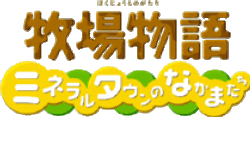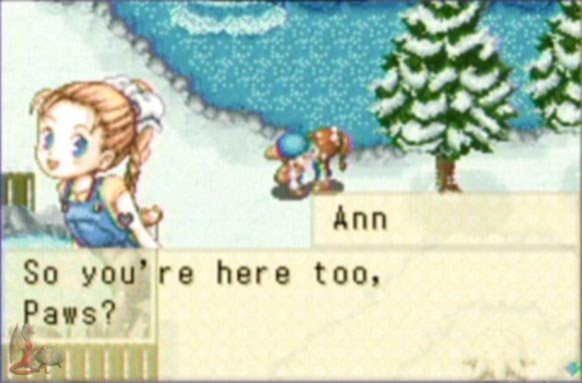|
|

|
FARMING SYSTEM
|

|
INTERACTION
|

|
ORIGINALITY
|

|
STORY
|

|
MUSIC & SOUND
|

|
VISUALS
|

|
CHALLENGE
|
Easy
|
COMPLETION TIME
|
20-50 hours
|
|
OVERALL
3.5/5
|
Rating definitions
|
|
|
At first glance, a game based off of farming would seem like a peculiar concept. While sim games have tried this before, never has it been used in an RPG-style setting. The Harvest Moon series began on the Super Nintendo, but did not grow to popularity until later, having releases on the N64, Game Boy, and Game Boy Color systems. On the PlayStation, the series continued with Harvest Moon: Back To Nature which went on to be a popular title. It was no huge surprise to see that when the series took a jump onto the Game Boy Advance, that the first iteration is actually a remake of that PSOne title, and called Harvest Moon: Friends of Mineral Town. What it lacks in the way of storyline, it makes up for any lack by being a uniquely fun and addictive game with many different paths to take.
The player must always keep two goals in mind during the three years they have possession of the farm. While it is important that the farm prospers, it is equally important that the townspeople accept the new addition to their community, or he will be asked to leave. To prosper, the character must establish a successful farm involving both crops and livestock. Crops can be planted in the fields once they are cleared of weeds, rocks, and wood. These hindrances can be removed by a scythe, hammer, and axe respectively. As tools are used, they gain experience. Every 100 experience points12, they may be upgraded with a new ore: bronze, silver, gold, or mythril. The blacksmith will upgrade all the basic tools, providing they have gained enough experience and an ore of the correct type is provided. Upgraded tools work more effectively, and can perform tasks that lower level tools cannot; large stumps and big rocks need to be destroyed with a higher level axe and hammer, or farming needs to be done around them. As for planting, the ground can be prepared by a hoe. Seeds are available at the local market, with selection varying by season. Each bag contains 9 seeds which the character throws up in the air, hopefully onto a three by three grid created beforehand. Every day, the growing plants need to be watered; while this is naturally done if there is rain, the character also has a refillable water can to perform the task with. At first, the character's backpack will be quite small, only holding three tools and two items, however this can be upgraded at the shop to five tools, four items and then later to nine tools, eight items. The character will need it for harvesting his crops. Each plant takes a specific number of days to grow, then blooms into fruit or vegetables which can then be picked and sold. Some plants can be harvested only once, such as turnips, while other plants will continue to provide new produce every few days, such as tomatos. Grass can also be planted, and never needs to be replaced. Grass can be cut down and become fodder for the barn, which would otherwise need to be purchased.
 Friendly Redhead
Friendly Redhead
|
|
At the beginning of the game, a puppy is provided to the boy for companionship. It will eventually grow into an adult dog. A horse will also be provided to the farm but unless the horse is given plenty of attention and care, after a year it will be taken away. It is kept in its own stable. While neither of these contribute directly to the farm, cows and sheep may be kept for profit. These animals are housed in the barn. The player can either buy one or the other, or once they own at least one cow or sheep, a miracle pill can be used to impregnate them, so that in a few days' time, a baby cow or sheep will be born. Like real animals, they must be fed and cared for daily. A brush can be used on them to increase their love for the character; the more affection they have, the better quality their milk and wool will be. Naturally, a milker and clippers will be needed to perform these actions. While the player begins with the basic tools, the three needed for animal care need to be purchased from the blacksmith. While the larger animals can be purchased from the same neighboring farm, chickens can also be acquired from a different neighbor. These cluckers can be either kept in the chicken coop with their own feed, or may be taken outside to find food for themselves. Chicken feed can either be purchased or corn can be grown during the summer and processed down into feed. Luckily enough, the mill to do so is right beside the coop. Between animals, big and small, as well as a variety of plants each season, there are plenty of farming opportunities to be had.
Other places of note in town include locations like the bar, the only place in town with a phone; a clinic, where the character goes if he becomes ill; the town square, where many festivals are held; or the library, where an attractive young lady is working. There are six women around town who are eligible bachelorettes looking for a husband. Courting one, or more than one, is entirely optional, but whichever ladies the character does not end up with will often find a suitable husband on their own. The character's wife may even end up becoming pregnant and having a child. In order to get married, the character's house must be expanded enough to serve two people; the barn and chicken coop may be upgraded in a similar fashion. One must never forget the important social aspect of the game between long hard days of back-breaking farm work.
The music is quaint and generally fitting. While it does set the mood of a small farm and accompanying village, it doesn't stand out in any fashion. The different tunes do change between various times of day as well as each season, which usually means by the time a player is sick of a particular kind of music, the seasons have changed over and a new tune is available to become eventually aggravated with. Most will choose to turn off the music by the time the first year is done, simply so that they needn't sit through the same music during successive years. The visuals fare a little better, and although running is somewhat choppy, the animals, people and environments are colorful and well done. The graphics seem to have been upgraded slightly from the original PlayStation version of the game, which was a nice touch.
Friends of Mineral Town can be as hard or as easy as the player chooses to make it. Planting huge fields while maintaing a giant barn will mean a lot of work just trying to get everything that needs to be squeezed into the day completed. Those that choose a more conservative approach will find that they will have more free time to explore the town, socialize with the ladies, and develop positive relationships with their neighbors. Both approaches are equally enjoyable, and all three of the years will take a player anywhere from a short 20 hours to upwards of 50 hours, depending upon which activities the farmboy applies himself to.
 Clearing The Fields
Clearing The Fields
|
|
The menu system is efficient and many different menus are quickly accessible using different combinations of buttons. This is especially handy when doing repeated actions such as checking on the health of animals, choosing tools, and harvesting produce. The menus also include maps for both the farm as well as the town and surrounding area, and are handy when first getting started. The farm map also shows where animals currently are, and how many; the location of the farm's dog and horse; what crops have been planted; and when the farm's buildings have been built up. The localization shows a marked amount of care has been put into getting text right; considering the large amount of text in a seemingly simple game, a solid localization is very important. While there is the occasional typographical error, these are few and far between and do not interfere with the actual gameplay, making the localization a pleasant experience.
The originality of Friends of Mineral Town is a mixed bag. It is, after all, a port of a game, so it is difficult to truly judge how original it is, as comparing it to the original version shows little to nothing has been changed. However, the Harvest Moon series works on a premise that few other RPGs attempt, pushing interesting gameplay and a storyline without using conflict. Games that do not rely on turn based combat have been gaining additional support but this was one of the first attempts. Like the other games in the series, however, there is very little in the way of story. The entire premise of the game is set up in the first five minutes of the game, and additional story is meted out in very small portions as different festivals pass by, time-sensitive events trickle in, and storyline snippets are triggered by being in the right place at the right time. Those looking for a deep storyline will definitely want to look elsewhere, but do not be fooled: the game needs only minimal storyline to support an otherwise solid game.
Harvest Moon: Friends of Mineral Town is proof that a game can be more than the sum of its parts. While the idea seems silly to many at first, the game is strangely addictive and even more enjoyable as a portable title. While very little was changed, this is an excellent way for new farmers to get into the series as well as a way for veterans to enjoy the best that it has to offer. While many people scoff the game, it is invariably those same people who end up being the most addicted to the title. With many different versions of the Harvest Moon games are now available, it is a perfect time for those who have never tried it to jump in, and for those that have enjoyed the series all along to remember what they've been missing in their other games lately.
Review Archives
|









